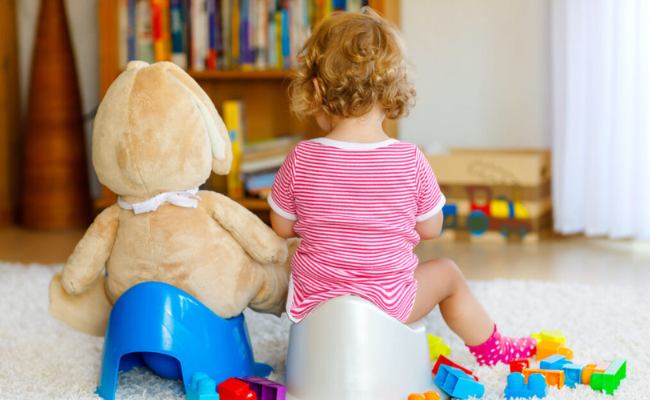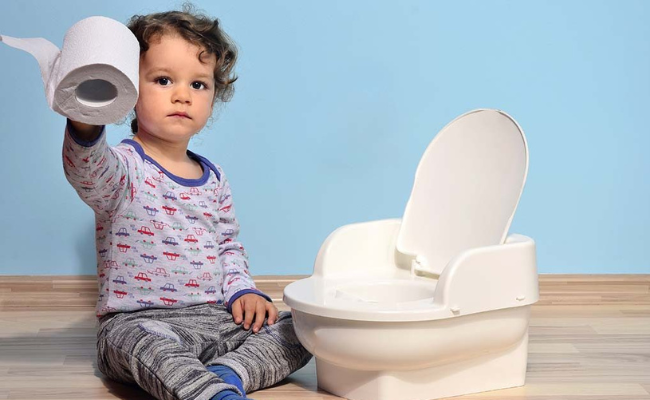Potty Training: When to Start This Fun Adventure
Potty training is an essential milestone for children and marks the start of a new phase in their development. However, many parents need help knowing when to start and how to make it exciting for their kids.
The key to success here is patience and understanding that all toddlers achieve this skill at their own pace. However, you may need to modify some methods for children with special healthcare needs.
This article teaches parents how to train their children to sit on the potty. You’ll learn some potty training tips to make it an enjoyable experience for you and your toddler. Though different children will require different strategies, these generally get the job done.
Signs Your Child Is Ready for Potty Training

Photo credit: Adobe Stock
Waiting until your child is ready can make the process smoother, less stressful, and more successful. Starting too early can lead to frustration for you and your child, and it may take longer to succeed. Physical signs to look out for include:
- Your child can walk and sit down without help.
- Your child is showing signs of bowel regularity.
- Your child’s diaper stays dry for more extended periods.
You may also like: Best Potty Training on Amazon
Tips for Making Potty Training Fun
Potty training can be challenging for both parents and children. However, you can help your child feel excited and empowered about this new stage. Here are some fun ideas for potty training your child:
Create a Potty Training Chart
Kids are naturally drawn to visuals. A toilet training chart can be a fun and engaging way to monitor their progress and celebrate their successes. Decorate the chart with colorful stickers, shimmering glitter, and other playful elements. Make the experience even more rewarding by involving your child in picking out a treat for each milestone they reach.
Read Potty Training Books
You can read many fun and engaging children’s books about potty training with your child. These books can help them understand what’s expected of them and get them excited about using the potty.
Let Your Child Choose Their Potty Seat
Giving them a choice in the type of potty seat can make them feel more in control of the process. Let them choose a colorful or character-themed seat they like and want to use.
Turn Potty Training into a Game
Kids love games, so try some potty-training games. Put some food coloring in the toilet water. Your child will see them change color during pees and poops.
Celebrate Successes

Photo credit: Adobe Stock
Celebrate every success, no matter how small. Whether it’s a high-five, a hug, or a dance party, ensure your child knows you’re proud of them.
A positive potty training experience can boost your child’s confidence and help control their bodily functions, boosting their self-esteem. It can also strengthen the parent-child bond and create positive memories of this milestone.
When to Start Potty Training
The average age range for potty training is 18 months to 3 years old. However, every child is unique and may have different readiness signs. Some children may show readiness signs earlier, such as showing interest in using the potty or imitating adults using the bathroom.
Others may show readiness signs later. You might see your child following simple instructions, communicating their needs, and controlling their bladder and bowel movements.
Strategies for Successful Potty Training
Parents can use various approaches to potty training to help their children transition from diapers to the toilet. Two popular methods are the “3-day” and the “gradual approach.”
3-Day Potty Training Method
A 3-day method is an intensive approach to potty training. Parents set aside time, usually 30 minutes to an hour, to focus solely on training their children. Some parents typically complete this over a long weekend.
During this time, children will wear underwear instead of diapers. Parents regularly remind them to use the potty and offer incentives for successful attempts. With this method, children can quickly learn to associate the urge to use the toilet.
Gradual Potty Training Approach
On the other hand, the gradual approach is more relaxed. Here, parents can gradually introduce the concept of potty training to their children over several weeks or months. This may include introducing a potty chair and encouraging the child to sit on it with their clothes on.
They gradually remove their clothes while still in diapers and eventually transition to “big kid” underwear. Parents may also use rewards and positive reinforcement to encourage their child’s progress.
Which Is the Better Potty Training Method?
The 3-day method may be more effective for families with a tight schedule or parents wanting to complete potty training quickly. However, it may be stressful for both the child and the parent. Also, some children may need more time for this intensive approach.
The gradual method is ideal for children needing more time to adjust to potty use. It also works for those who are more sensitive to change. It can also be less stressful for parents and allow a more flexible schedule.
The best approach depends on your child’s personality, developmental readiness, and the family’s lifestyle and preferences.
Common Potty Training Challenges and Solutions

Photo credit: Adobe Stock
Parents may encounter common issues during potty training. Your child might have a few accidents, regress, refuse to use the potty, and have difficulty recognizing the need to go.
To address these issues, parents can try several strategies:
Remember to remain positive throughout the process and avoid any negative interactions. Instead, you should encourage your child to try again and reinforce positive behavior with praise and rewards.
For accidents, you can gently remind the child to use the potty regularly, especially after meals or when they wake up. It can also be helpful to keep your child in easy-to-remove clothing during the early stages of potty training.
If your child regresses, try to identify and address the regression’s cause. You can also re-establish a routine, reinforce positive behavior, and provide extra support and encouragement.
You may also like: Best Potty Training Essentials on Amazon
Conclusion
Parents should approach potty training as an adventure for their children, making it a positive experience for them. Remember to look for physical signs like independent walking, bowel regularity, and longer dry diaper periods.
Some behavioral signs can help you identify if your child is ready. These can include interest in the bathroom, discomfort when the diaper is wet, and the ability to follow instructions.
Parents can make the potty training experience enjoyable for themselves and their children. This will ensure a successful and stress-free process.
FAQs: Is My Child Ready for Potty Training?
1. What age should you start potty training?
Children are typically ready to begin potty training between 18 and 36 months, but individual readiness can vary.
2. What are some signs that my child is ready for potty training?
Each child is different and will show different signs they’re ready. Here are some general signs to look out for:
- Showing interest in the toilet.
- Staying dry for longer.
- Expressing discomfort with wet or soiled diapers.
3. How can I make potty training fun for my child?
Consider the following tips to achieve fun potty training successes:
- Use sticker charts.
- Read potty training books.
- Allow your child to pick out their potty chair.
4. What are some tips for successful potty training?
Training your child to use the toilet can be challenging. Consistency, positive reinforcement, and patience with your child can help them overcome this hump.
5. What are some common challenges with potty training, and how can I overcome them?
If you think your child is having some troubles, this is normal! There will be a few accidents, they might resist using the toilet, and they probably will regress.
Try offering rewards, understanding your child, and seeking help from a doctor if necessary. Don’t be afraid to throw in the towel (and toilet paper) for a few weeks before you try again.

